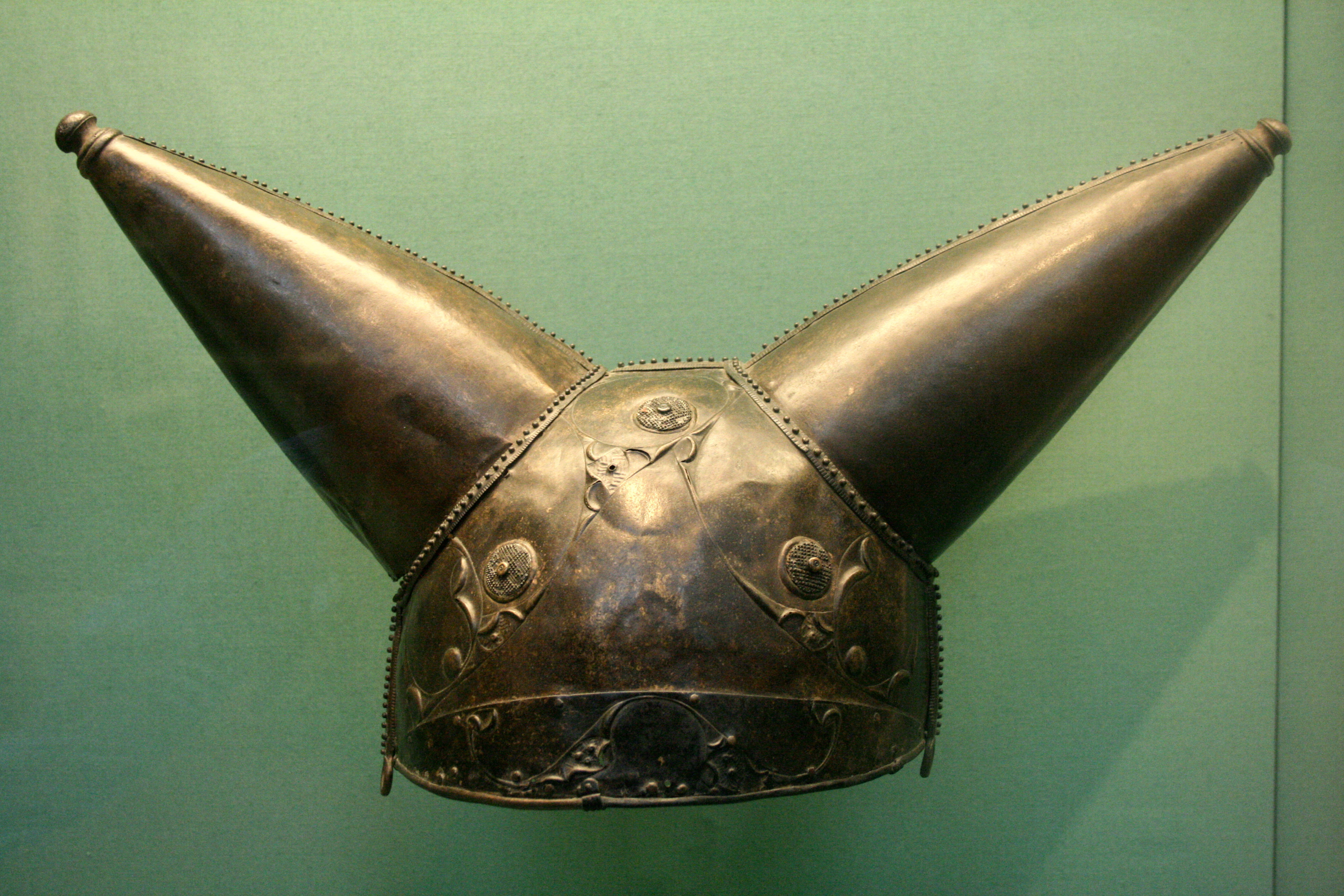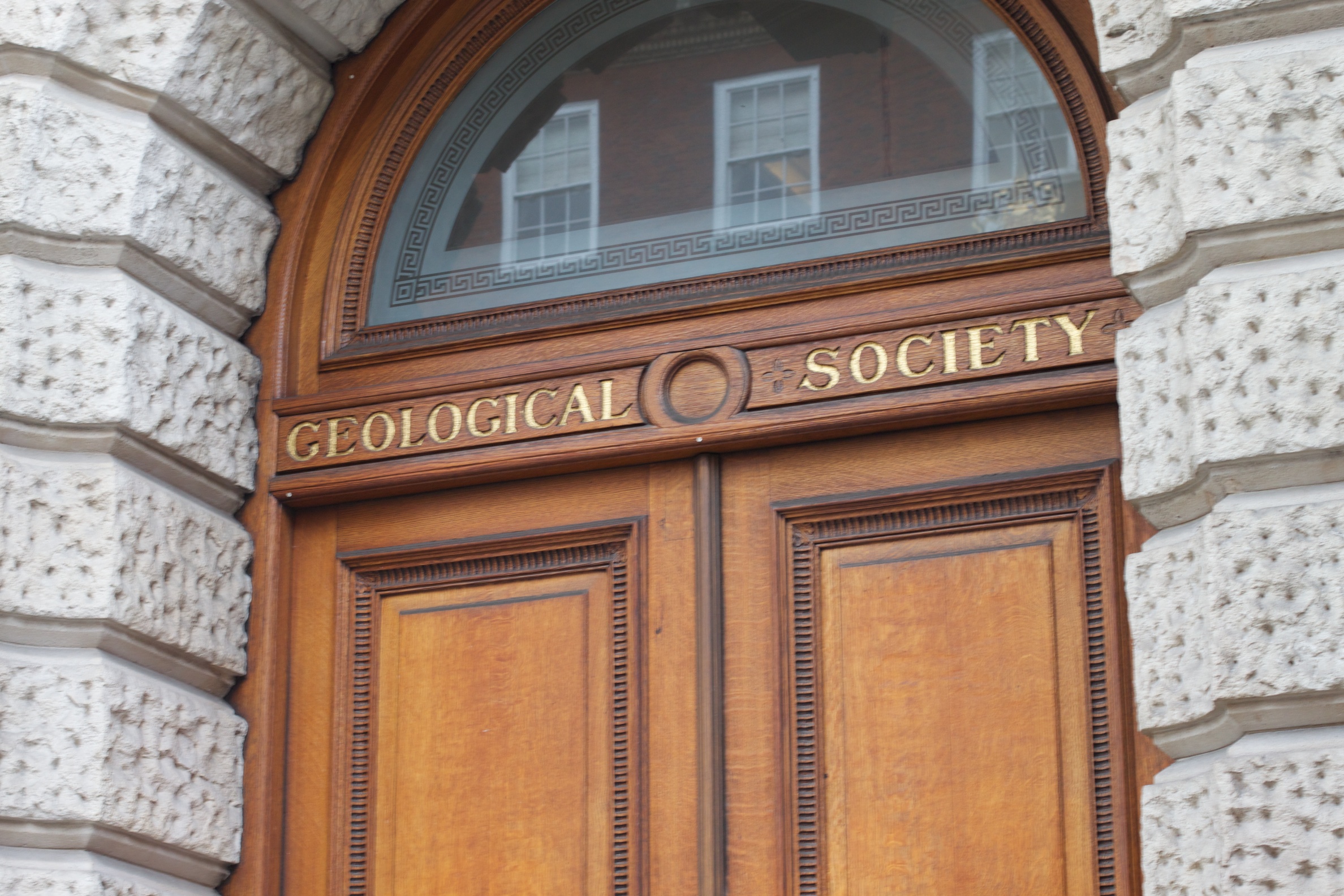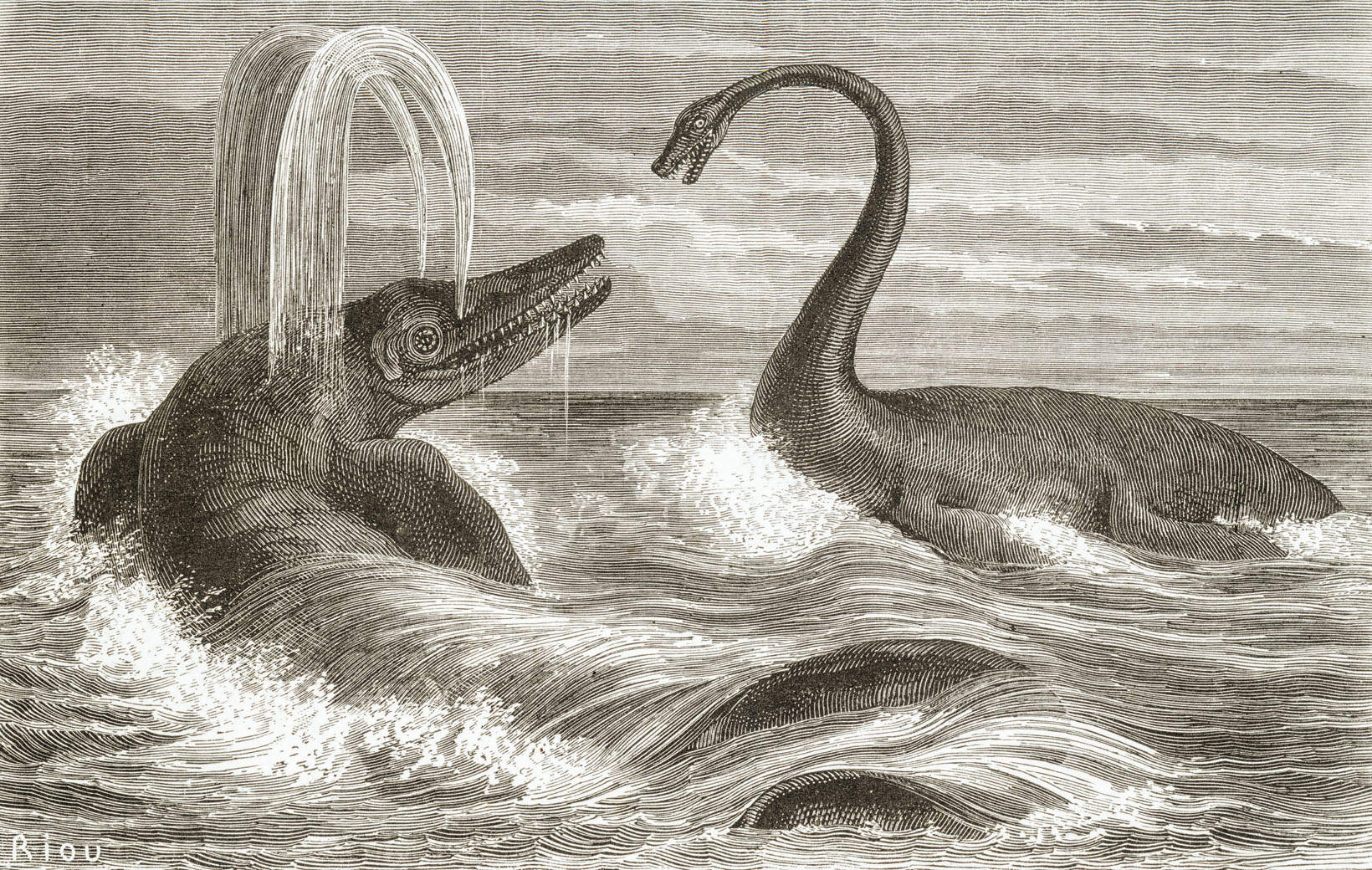|
Jacob Wilkinson (naturalist)
Jacob Wilkinson (1773–1844) was an English naturalist working in the fields of geology and paleobiology. Life Born in the City of London on 28 April 1773, he was the fifth surviving son of John Wilkinson (1732-1779), a wealthy businessman, and his wife Sibella Berdoe (1737-1807), daughter of his father's business partner John Berdoe. It is possible he was named after Jacob Wilkinson, a friend and maybe business associate of his father. Living all his adult life outside Bath, Somerset, he became a keen collector of fossil remains of extinct creatures found in the area. In 1801 he acquired a huge mammoth tusk 2.4 metres (8 feet) long, together with other remains from the same site. These he presented to the Geological Society of London, who in 1807 made him one of their first honorary members. In 1805, he found the skeleton of an ichthyosaur at Weston, Bath. By 1811 he was reported to have perhaps the finest private collection of fossil bones in England, which he was glad to s ... [...More Info...] [...Related Items...] OR: [Wikipedia] [Google] [Baidu] |
Naturalist
Natural history is a domain of inquiry involving organisms, including animals, fungi, and plants, in their natural environment, leaning more towards observational than experimental methods of study. A person who studies natural history is called a naturalist or natural historian. Natural history encompasses scientific research but is not limited to it. It involves the systematic study of any category of natural objects or organisms, so while it dates from studies in the ancient Greco-Roman world and the mediaeval Arabic world, through to European Renaissance naturalists working in near isolation, today's natural history is a cross-discipline umbrella of many specialty sciences; e.g., geobiology has a strong multidisciplinary nature. Definitions Before 1900 The meaning of the English term "natural history" (a calque of the Latin ''historia naturalis'') has narrowed progressively with time, while, by contrast, the meaning of the related term "nature" has widened (see also ... [...More Info...] [...Related Items...] OR: [Wikipedia] [Google] [Baidu] |
Geology
Geology (). is a branch of natural science concerned with the Earth and other astronomical objects, the rocks of which they are composed, and the processes by which they change over time. Modern geology significantly overlaps all other Earth sciences, including hydrology. It is integrated with Earth system science and planetary science. Geology describes the structure of the Earth on and beneath its surface and the processes that have shaped that structure. Geologists study the mineralogical composition of rocks in order to get insight into their history of formation. Geology determines the relative ages of rocks found at a given location; geochemistry (a branch of geology) determines their absolute ages. By combining various petrological, crystallographic, and paleontological tools, geologists are able to chronicle the geological history of the Earth as a whole. One aspect is to demonstrate the age of the Earth. Geology provides evidence for plate tectonics, the ev ... [...More Info...] [...Related Items...] OR: [Wikipedia] [Google] [Baidu] |
Paleobiology
Paleobiology (or palaeobiology) is an interdisciplinary field that combines the methods and findings found in both the earth sciences and the life sciences. An investigator in this field is known as a paleobiologist. Paleobiology is closely related to the field of paleontology, although the latter focuses primarily on the study and taxonomic classification of fossil records, while paleobiology incorporates a broader ecological, evolutionary and geological perspectives of the history of life on Earth. It is also not to be confused with geobiology, which focuses more on the contemporary interactions between the modern biosphere and the physical Earth. Paleobiological research uses biological field research of current biota and of fossil evidence millions of years old to draw parallel and answer questions about the molecular evolution and the evolutionary history of life. In this scientific quest, macrofossils, microfossils and trace fossils are typically analyzed. H ... [...More Info...] [...Related Items...] OR: [Wikipedia] [Google] [Baidu] |
City Of London
The City of London, also known as ''the City'', is a Ceremonial counties of England, ceremonial county and Districts of England, local government district with City status in the United Kingdom, city status in England. It is the Old town, historic centre of London, though it forms only a small part of the larger Greater London metropolis. The City of London had a population of 8,583 at the 2021 United Kingdom census, 2021 census, however over 500,000 people were employed in the area as of 2019. It has an area of , the source of the nickname ''the Square Mile''. The City is a unique local authority area governed by the City of London Corporation, which is led by the Lord Mayor of London, Lord Mayor of the City of London. Together with Canary Wharf and the West End of London, West End, the City of London forms the primary central business district of London, which is one of the leading financial centres of the world. The Bank of England and the London Stock Exchange are both ba ... [...More Info...] [...Related Items...] OR: [Wikipedia] [Google] [Baidu] |
Jacob Wilkinson
Jacob Wilkinson (c. 1722–1799) was an English businessman who served as an MP and as a director of the East India Company. Career According to Sir Lewis Namier, he was a Presbyterian from Berwick-upon-Tweed who became rich as a businessman and banker in London. By 1757 he was appearing in commercial directories and by 1759 was a substantial investor in government stock. At some point he also acquired lands and slaves in the West Indies, at his death holding the estate of Hoghole in the parish of St Thomas-in-the-Vale on Jamaica and another estate on Tobago. He retained links with his birthplace, where in 1765 he was mentioned as a political opponent of Hugh Percy, 1st Duke of Northumberland's supporters and in the general election of 1774 came top of the poll, becoming MP for Berwick-upon-Tweed in the Parliament of Great Britain. He did not stand again in the 1780 general election, but in 1781 won a seat at Honiton. While sitting, he also sought election as a director of ... [...More Info...] [...Related Items...] OR: [Wikipedia] [Google] [Baidu] |
Bath, Somerset
Bath (Received Pronunciation, RP: , ) is a city in Somerset, England, known for and named after its Roman Baths (Bath), Roman-built baths. At the 2021 census, the population was 94,092. Bath is in the valley of the River Avon, Bristol, River Avon, west of London and southeast of Bristol. The city became a UNESCO World Heritage Site in 1987, and was later added to the transnational World Heritage Site known as the "Great Spa Towns of Europe" in 2021. Bath is also the largest city and settlement in Somerset. The city became a spa with the Latin name ' ("the waters of Sulis") 60 AD when the Romans built Roman Baths (Bath), baths and a temple in the valley of the River Avon, although List of geothermal springs in the United Kingdom, hot springs were known even before then. Bath Abbey was founded in the 7th century and became a religious centre; the building was rebuilt in the 12th and 16th centuries. In the 17th century, claims were made for the curative properties of water ... [...More Info...] [...Related Items...] OR: [Wikipedia] [Google] [Baidu] |
Mammoth
A mammoth is any species of the extinct elephantid genus ''Mammuthus.'' They lived from the late Miocene epoch (from around 6.2 million years ago) into the Holocene until about 4,000 years ago, with mammoth species at various times inhabiting Africa, Asia, Europe, and North America. Mammoths are distinguished from living elephants by their (typically large) spirally twisted tusks and in some later species, the development of numerous adaptions to living in cold environments, including a thick layer of fur. Mammoths and Asian elephants are more closely related to each other than they are to African elephants. The oldest mammoth representative, '' Mammuthus subplanifrons'', appeared around 6 million years ago during the late Miocene in what is now southern and Eastern Africa.'''' Later in the Pliocene, by about three million years ago, mammoths dispersed into Eurasia, eventually covering most of Eurasia before migrating into North America around 1.5–1.3 million year ... [...More Info...] [...Related Items...] OR: [Wikipedia] [Google] [Baidu] |
Geological Society Of London
The Geological Society of London, known commonly as the Geological Society, is a learned society based in the United Kingdom. It is the oldest national geological society in the world and the largest in Europe, with more than 12,000 Fellows. Fellows are entitled to the postnominal FGS (Fellow of the Geological Society), over 2,000 of whom are Chartered Geologists (CGeol). The Society is a registered charity, no. 210161. It is also a member of the Science Council, and is licensed to award Chartered Scientist to qualifying members. The mission of the society is: "Making geologists acquainted with each other, stimulating their zeal, inducing them to adopt one nomenclature, facilitating the communication of new facts and ascertaining what is known in their science and what remains to be discovered". History The Society was founded on 13 November 1807 at the Freemasons' Tavern, Great Queen Street, in the Covent Garden district of London. It was partly the outcome of a previou ... [...More Info...] [...Related Items...] OR: [Wikipedia] [Google] [Baidu] |
Ichthyosaur
Ichthyosauria is an order of large extinct marine reptiles sometimes referred to as "ichthyosaurs", although the term is also used for wider clades in which the order resides. Ichthyosaurians thrived during much of the Mesozoic era; based on fossil evidence, they first appeared around 250 million years ago ( Ma) and at least one species survived until about 90 million years ago, into the Late Cretaceous. During the Early Triassic epoch, ichthyosaurs and other ichthyosauromorphs evolved from a group of unidentified land reptiles that returned to the sea, in a development similar to how the mammalian land-dwelling ancestors of modern-day dolphins and whales returned to the sea millions of years later, which they gradually came to resemble in a case of convergent evolution. Ichthyosaurians were particularly abundant in the Late Triassic and Early Jurassic periods, until they were replaced as the top aquatic predators by another marine reptilian group, the Plesiosauria, i ... [...More Info...] [...Related Items...] OR: [Wikipedia] [Google] [Baidu] |
Weston, Bath
Weston is a suburb and Wards of the United Kingdom, electoral ward of Bath, Somerset, Bath in Bath and North East Somerset, Somerset, England, located in the northwest of the city. Originally a separate village, Weston has become part of Bath as the city has grown, first through the development of Lower Weston in Victorian times and then by the incorporation of the village into the city, with the siting of much local authority housing there in the period after World War II. The ward includes Upper Weston, Weston village, Weston Park and the lower slopes of Primrose Hill. The area known as Lower Weston, south of Weston Road, is within Newbridge, Bath, Newbridge ward. History The earliest evidence of occupation comes from two Celtic caddy spoons found in the village in 1825. There are believed to have been used as ceremonial anointing regalia. During the 10th century, Weston had been divided into two estates. One, on the slopes of Lansdown, Bath, Lansdown was given by Edmund I to ... [...More Info...] [...Related Items...] OR: [Wikipedia] [Google] [Baidu] |
Charles Edmund Wilkinson
Charles Edmund Wilkinson (1801 – 3 June 1870) was a British army officer who rose to the rank of Major-General and served as acting Governor of British Ceylon. Life Born 1801, he was the only son of the naturalist Jacob Wilkinson (1773–1844) and his first wife Olivia Maria Cranke Stephen (1771–1815). Pursuing a military career in the Royal Engineers, he rose to captain in 1846, lieutenant-colonel in 1854, brevet-colonel in 1858, and in 1859 was promoted to full colonel. On 30 July 1860, he was appointed acting Governor of British Ceylon British Ceylon (; ), officially British Settlements and Territories in the Island of Ceylon with its Dependencies from 1802 to 1833, then the Island of Ceylon and its Territories and Dependencies from 1833 to 1931 and finally the Island of Cey ..., a post he held until 22 October 1860 when he was succeeded by Charles Justin MacCarthy. In 1866, he achieved his final promotion to major-general and died on 3 June 1870, aged 68 or 6 ... [...More Info...] [...Related Items...] OR: [Wikipedia] [Google] [Baidu] |
1773 Births
Events January–March * January 1 – The hymn that becomes known as '' Amazing Grace'', at this time titled "1 Chronicles 17:16–17", is first used to accompany a sermon led by curate John Newton in the town of Olney, Buckinghamshire, England. * January 12 – The first museum in the American colonies is established in Charleston, South Carolina; in 1915, it is formally incorporated as the Charleston Museum. * January 17 – Second voyage of James Cook: Captain Cook in HMS Resolution (1771) becomes the first European explorer to cross the Antarctic Circle. * January 18 – The first opera performance in the Swedish language, ''Thetis and Phelée'', performed by Carl Stenborg and Elisabeth Olin in Bollhuset in Stockholm, Sweden, marks the establishment of the Royal Swedish Opera. * February 8 – The Grand Council of Poland meets in Warsaw, summoned by a circular letter from King Stanisław August Poniatowski to respond to the Kingdom ... [...More Info...] [...Related Items...] OR: [Wikipedia] [Google] [Baidu] |







